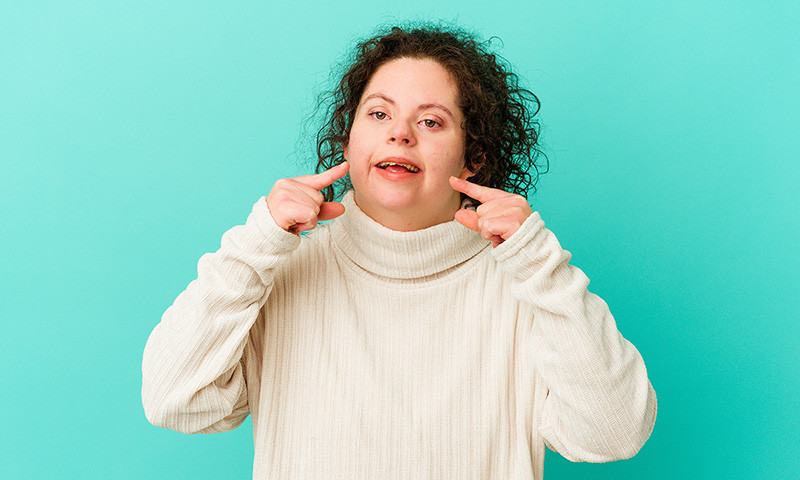Definition: What is bad breath?
Pretty much everyone has bad breath (medical term: halitosis, derived from Latin halitus, meaning: whiff, breath) at some point – for example, after drinking alcohol, eating a garlic-laden meal or first thing in the morning. The causes of this type of bad breath can, therefore, be found directly in the oral cavity. In this case, the malodour is also called transient halitosis or physiological halitosis. This type of bad breath is common, harmless and can be treated effectively with proper oral hygiene.
In addition to this temporary form of bad breath, there is also "genuine bad breath", which does not simply disappear by itself. Eliminating genuine halitosis poses a much greater challenge. The odour is usually so strong that it clearly exceeds socially acceptable levels. This is referred to as pathological halitosis. It can be due to a medical condition. Poor oral hygiene, however, may also be the culprit.
When it comes to pathological halitosis, a differentiation is made between intra-oral and extra-oral triggers. With extra-oral factors, an unpleasant odour is emitted from both the mouth and the nose when exhaling. Discover the precise nature of intra-oral and extra-oral causes here.
What causes bad breath?
In around 90 percent of cases, bad breath is attributable to our oral cavity. It is usually caused by a build-up of bacteria, of which there are hundreds of different species, in our mouth. They thrive on remnants of food between the teeth, in the gum pockets and on the tongue. As it decays, the food debris produces sulphur-containing compounds. This is a completely normal process that does not automatically lead to bad breath. A malodour only becomes noticeable when the number of bacteria increases beyond the normal range. This can easily be prevented from happening through good oral hygiene. Our saliva also helps to keep bacteria levels under control.
Bad breath in various stages of life
Bad smelling breath can occur at any age. However, surveys have shown that bad breath appears to be more prevalent in people above the age of 50. That said, there are several other stages of life that may actually promote bad breath. Discover which they are below.
Bad breath in babies
Teething
Babies can suffer from bad breath when they start teething. The reason for this is an increase in salivation with the eruption of new teeth. The warm and moist mouth is an ideal breeding ground for bacteria. This type of bad breath is usually nothing to worry about.
Good to know:
Bad breath in babies and very young children may also occur if a foreign object becomes stuck in their nasal passages – for example, a bead, bean or small toy. Do you have this suspicion? If so, definitely have your child examined by a health care professional.
Bad breath in children and young people
The causes of bad breath in children and young people are similar to those in adults.
Here are a few examples:
- Dry mouth
- Poor oral hygiene
- Tooth decay
- Sugary drinks and food
- Residue on tongue
- Symptoms of an illness (see: Halitosis)
- Dehydration
What does bad breath smell like? Types of bad breath
Odours differ – this also applies to bad breath. Sometimes it smells rather foul, sometimes metallic or chemical. It will be easier to get rid of your bad breath once you understand what the different odours mean. Your health care professional will help you. Do you want to know more about it? Below, we have put together everything you need to know:
Bad breath smelling of rotten eggs or rotting cabbage
If your breath smells of rotten eggs, sulphurous gases, such as hydrogen sulphide and methyl mercaptan, are usually the main offenders. They are caused by the bacterial decomposition of food debris in our oral cavity. If it smells of rotten eggs, hydrogen sulphide is often the culprit. If it smells of rotting cabbage or smelly socks, your bad breath can probably be attributed to methyl mercaptan.
Bad breath smelling of faeces, fish or decaying meat
If your breath smells fishy, of decaying meat or even faeces, biogenic amines are usually to blame. They are mainly formed by the bacterial decarboxylation of amino acids.
Metallic or chemical smelling breath
Bad breath that smells metallic could indicate dental or stomach problems. Sufferers sometimes experience a metallic taste in their mouths. A chemical smell can be the result of fasting. Our body does not get any sugar during this period. The consequence: It starts breaking down fat and the liver produces ketone bodies, which then exit our body – for example through our breath. This can give off a smell similar to nail varnish remover.
Breath smelling of cheese or eggs
If your breath smells of cheese or eggs, it is usually because you have just eaten these foods. They are rich in sulphur and a common cause of bad breath. This is not only down to the taste of eggs and cheese, but also due to the fact that they contain many proteins that help bacteria grow and thrive in your mouth.
Sweet smelling breath
If bad breath smells very sweet, a disturbance of the sugar metabolism could be the root cause – the person affected probably has some form of diabetes, for example. The malodour could also be a sign of liver disease. But again: Self-diagnoses can be hazardous. It is always best to have things checked by a health care professional.
Sour or bitter smelling breath
Sour smelling breath or bad breath accompanied by a bitter taste commonly emanates from the stomach. Your bad breath then smells of stomach acid. This condition is most commonly associated with heartburn or a stomach infection. Again, it is best to consult a health care professional about any bad breath issues to rule out any underlying health conditions.
Determining bad breath: With these simple tests
Bad breath is an embarrassing condition for sufferers – and an often unpleasant one for others. Since many people are blissfully unaware of their bad breath. Part of the reason for this is that they have long become accustomed to the odour. To make sure your breath is nice and fresh, you can perform several simple tests.
Sniff test
Cup your hands, cover your mouth and exhale into them. Then sniff your cupped hands quickly to smell the exhaled air.
Plastic bag test
Blow into a small plastic bag and then let the air escape slowly. Put your nose at the opening and smell the escaping air.
Tongue scraper, spoon or cotton bud test
Take a tongue scraper or a spoon (without sharp edges) and remove a little coating from your tongue. You can also use a cotton bud to do this. Wait a few seconds and then smell it.
Good to know:
You can train your self-awareness for bad breath by licking the back of your hand every now and then, letting the saliva dry for roughly ten seconds and then smelling the result. If you notice you have bad breath, simply chew on some gum to freshen your breath or – if you are at home – brush your teeth.
Halitosis test
If you want to know for sure, take the halimeter test or halitosis test. This uses an oral malodour tester equipped with a gas sensor. If you blow into it, it detects the concentration of volatile sulphur compounds in your saliva and breath, thereby determining in just a few seconds whether a malodour is present and how strong it is. Many surgeries are equipped to offer this test to their patients. Oral malodour testers can also be purchased online.
Eliminating bad breath: How to get rid of a malodour
Bad breath can usually be eliminated quite simply. However, it is important that your bad breath comes directly from your mouth and is not caused by some other underlying health condition. If in doubt, you should always consult a health care professional.
Harmless bad breath: What can you do?
If you want to get rid of your bad breath, the most effective treatment is to simply brush your teeth with a suitable toothbrush and a high-quality toothpaste. Remember to clean between your teeth with an interdental brush, as that is where lots of bacteria tend to linger and breed. Good oral hygiene will help keep your breath fresh. Moreover, there are many other ways to neutralise and fight bad breath.
Home remedies
Lemon juice
Mix a few drops of lemon juice with water to make an effective gargle. This should help stimulate the flow of saliva and thus improve your oral health.
Sea salt
Also for gargling: Dissolve a teaspoon of sea salt in warm water and rinse your mouth and throat with the solution. This achieves a disinfecting effect.
Fruit and fresh vegetables
If you regularly eat celery, apples, etc., you not only benefit from the extra vitamins, but from a natural treatment for bad breath. Besides stimulating the flow of saliva, fruit and vegetables help to "scrape" any bacteria from the oral cavity.
Fennel seeds / Aniseeds
Chewing fennel seeds or aniseeds is considered an effective remedy for bad breath.
Ginger
Ginger is also said to eliminate bad breath – for example, pickled or as a chewy sweet.
Green tea
Since green tea has antibacterial properties, it helps fight bacteria in the oral cavity and neutralise bad breath.
Cinnamon
Cinnamon contains essential oils and is thus also an effective home remedy for bad breath.
Natural yoghurt
Natural yoghurt is rich in lactic acid bacteria, which prevent the spread of the bacteria that cause bad breath.
Chewing gum
Chewing gum is an effective way to get rid of bad breath fast. This is a good alternative, especially when you are out and about and unable to brush your teeth. Chewing gum stimulates the flow of saliva, thereby rinsing sugar and other food debris out of the oral cavity.
However, it is important to use sugar-free chewing gum to help prevent tooth decay. If you pick a chewing gum with xylitol, there is another advantage, too: The sweetener replaces sugar, which feeds the bacteria in our oral cavity. These bacteria produce acid that erodes the enamel of your teeth over time. Xylitol, in contrast, stops sugar being converted into acid by the bacteria. Therefore, chewing gum not only fights bad breath, but can also protect your teeth from decay.
Lozenges
Lozenges have a similar effect to chewing gum. They stimulate the flow of saliva, thus combating dry mouth symptoms, which can often be a cause of bad breath. Moreover, the increased saliva rinses and removes unwanted food from your mouth and reduces the amount of oral bacteria.
 Swiss premium oral care
Swiss premium oral care












